Section 05-02G: Axle, Integral Carrier, 8.8-Inch Ring Gear | 1996 F-150 and Bronco Workshop Manual |
DISASSEMBLY AND ASSEMBLY
Axle Assembly
SPECIAL SERVICE TOOL(S) REQUIRED
| Description | Tool Number |
|---|
| Pinion Bearing Cup Replacer | T67P-4616-A |
| Pinion Depth Gauge | T79P-4020-A |
| Pinion Seal Replacer | T83T-4676-A |
| Companion Flange Holding Tool | T78P-4851-A |
| Axle Wheel Bearing Replacer | T83T-1225-B |
| Hub Seal Replacer | T83T-1175-B |
| Differential Side Bearing Replacer | T57L-4221-A2 |
| Shim Driver | T85L-4067-AH |
Pinion Bearing Cup Installation
NOTE: Do not remove the drive pinion bearing cups from the carrier casting unless the drive pinion bearing cups are damaged.
Install the new drive pinion bearing cups with Pinion Bearing Cup Replacer T67P-4616-A as shown. Make sure the drive pinion bearing cups are properly seated in their bores. If a 0.038mm (0.0015-inch) feeler gauge can be inserted between a drive pinion bearing cup and the bottom of its bore at any point around the drive pinion bearing cup, the cup is not properly seated. Whenever the drive pinion bearing cups are replaced, the pinion bearing cone and roller assembly should also be replaced.

Drive Pinion Shim Selection
Variation in bearing widths and individual differences in machining the carrier and the differential ring gear and pinion (4209) require a drive pinion bearing adjustment shim (4663) between the differential pinion bearing (4630) and pinion head, in order to locate the pinion for correct tooth contact with the ring gear.
When replacing differential ring gear and pinion, the correct shim thickness for the new ring gear and pinion to be installed is determined by the following procedure using Pinion Depth Gauge T79P-4020-A.
Assemble the appropriate aligning adapter, gauge disc and gauge block to the screw. The gauge block must be offset 45 degrees to obtain an accurate reading.
Rear Axle Pinion Depth Gauge Tool
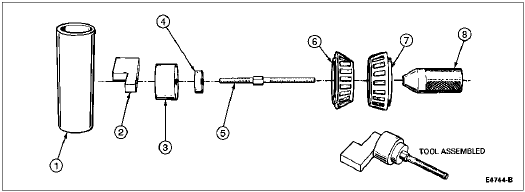
| Item | Part Number | Description |
|---|
| 1 | T79P-4020-A19 | Gauge Tube
(3.063 Inch O.D.)
(Part of T79P-4020-A) |
| 2 | T76P-4020-A10 | Gauge Block (1.7 Inch Thick) (Part of T79P-4020-A) |
| 3 | T79P-4020-A18 | Gauge Disc
(1.1884 Inch Thick)
(Part of T79P-4020-A) |
| 4 | T76P-4020-A3 | Aligning Adapter
(1.612 Inch O.D.)
(Part of T79P-4020-A) |
| 5 | T76P-4020-A9 | Screw (Part of T79P-4020-A) |
| 6 | 4630 | Differential Pinion Bearing (Inner) |
| 7 | 4621 | Differential Pinion Bearing (Outer) |
| 8 | T76P-4020-A11 | Handle
(Part of T79P-4020-A) |
Place the inner differential pinion bearing (new, or used if in good condition) over the aligning tool and insert it into the rear axle pinion bearing cup (4628) of the carrier. Place the outer differential pinion bearing (4621) into the differential drive pinion bearing cup (4616) and assemble the tool handle into the screw. Roll the assembly back and forth a few times to seat the bearings while tightening the tool handle by hand. Tighten the tool handle to 2.2 Nm (20 lb-in).

Center the gauge tube into the differential bearing bore. Install the bearing caps and tighten the bolts to 95-115 Nm (70-85 lb-ft). (Caps are to be installed with the triangles pointing outboard.)
Utilize pinion shims as the gauge for shim selection. This will minimize errors in attempting to stack feeler gauge stock together or simple addition errors in calculating correct shim thickness.
Pinion shims must be flat. Do not use dirty, bent, nicked or mutilated shims as a gauge.
A slight drag should be felt for correct shim selection. Do not attempt to force the pinion shim between the gauge block and the gauge tube. This will minimize selecting a pinion shim thicker than required, which results in a deep tooth contact in final assembly of integral rear axle assemblies (4006).
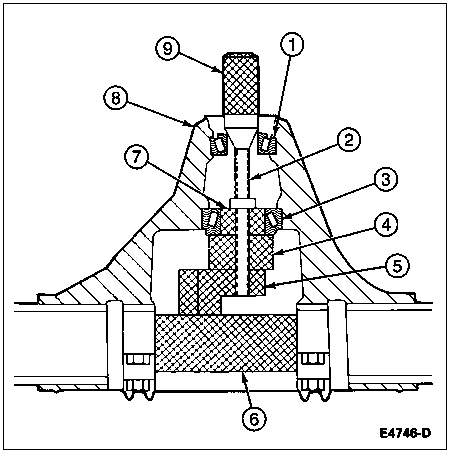
| Item | Part Number | Description |
|---|
| 1 | 4621 | Differential Pinion Bearing (Outer) |
| 2 | — | Screw T76P-4020-A9
(Part of T79P-4020-A) |
| 3 | 4630 | Differential Pinion Bearing (Inner) |
| 4 | — | Gauge Disc T79P-4020-A18 (Part of T79P-4020-A) |
| 5 | — | Gauge Block T76P-4020-A10
(Part of T79P-4020-A) |
| 6 | — | Gauge Tube T89P-4020-A19
(Part of T79P-4020-A) |
| 7 | — | Aligning Adapter T76P-4020-A3
(Part of T79P-4020-A) |
| 8 | 4010 | Rear Axle Housing |
| 9 | — | Handle T76P-4020-A11
(Part of T79P-4020-A) |
Drive Pinion and Flange Yoke Seal Installation
NOTE: The same differential pinion bearing used in the following step must be used in final assembly of the axle.
NOTE: Make sure press load is not applied to the bearing cage.
Place the selected pinion shims on the pinion shaft and press the inner differential pinion bearing until it is firmly seated on the shaft.

Check splines on the pinion shaft to be sure they are free of burrs. If burrs are evident, remove them by using a fine crocus cloth. Wipe the pinion clean.
Place new differential drive pinion collapsible spacer (4662) on the pinion shaft against the pinion stem shoulder.
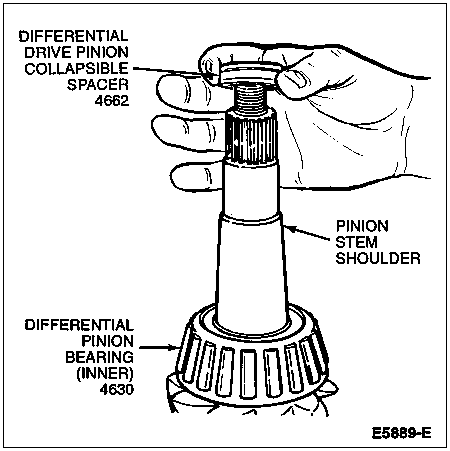
Install the front differential pinion bearing and rear axle drive pinion shaft oil slinger (4670) in the rear axle housing (4010) and install the rear axle drive pinion seal (4676) on the Pinion Seal Replacer T83T-4676-A.

 CAUTION: Installation without the proper tool may result in early seal failure. If rear axle drive pinion seal becomes cocked during installation, remove it and install new one.
CAUTION: Installation without the proper tool may result in early seal failure. If rear axle drive pinion seal becomes cocked during installation, remove it and install new one.
Clean the oil seal seat surface. Install the rear axle drive pinion seal in the rear axle housing using Pinion Seal Replacer T83T-4676-A. Coat the lips of the rear axle drive pinion seal with Premium Long-Life Grease XG-1-C or -K or equivalent meeting Ford specification ESA-M1C75-B.

From the rear of the rear axle housing, install the drive pinion assembly (drive pinion, drive pinion bearing adjustment shims, inner differential pinion bearing and differential drive pinion collapsible spacer) into the rear axle housing.

Universal Joint, Rear Axle Installation
Apply a small amount of lubricant to the companion flange splines.
NOTE: If a new rear axle universal joint flange (4851) is being installed, disregard the scribe mark on the pinion shaft.
NOTE: The rear axle universal joint flange must never be hammered on or installed with power tools.
Align the mark on the rear axle universal joint flange with the mark on the pinion shaft. Install the rear axle universal joint flange using Companion Flange Replacer TOOL-4858-E or equivalent.
Install a new pinion nut on the pinion stem.
Hold the circular rear axle universal joint flange with Companion
Flange Holding Tool T78P-4851-A while tightening the pinion nut (see Step 5).

Tighten the pinion nut, rotating the pinion occasionally to make sure pinion bearing cone and roller assemblies seat properly. Take frequent drive pinion bearing torque preload readings until the specified preload reading is obtained.
New Bearings: 1.8-3.3 Nm (16-29 lb-in)
Used Bearings: 0.9-1.5 Nm (8-14 lb-in)
Under no circumstances should the pinion nut be backed off to reduce preload. If reduced preload is required, a new collapsible spacer and pinion nut must be installed.

Wheel Bearing and Oil Seal Installation
 CAUTION: Installation of the rear wheel bearing (1225) or inner wheel bearing oil seal (1177) assembly without the proper tool may result in a bearing or seal failure. If inner wheel bearing oil seal becomes cocked in the bore during installation, remove inner wheel bearing oil seal and install a new inner wheel bearing oil seal.
CAUTION: Installation of the rear wheel bearing (1225) or inner wheel bearing oil seal (1177) assembly without the proper tool may result in a bearing or seal failure. If inner wheel bearing oil seal becomes cocked in the bore during installation, remove inner wheel bearing oil seal and install a new inner wheel bearing oil seal.
Lubricate the new rear wheel bearing with rear axle lubricant and install the rear wheel bearing into the housing bore using Axle Wheel Bearing Replacer T83T-1225-B.

Coat the lips of the inner wheel bearing oil seal with Premium Long-Life Grease XG-1-C or -K or equivalent meeting Ford specification ESA-M1C75-B and install the inner wheel bearing oil seal using Hub Seal Replacer T83T-1175-B.
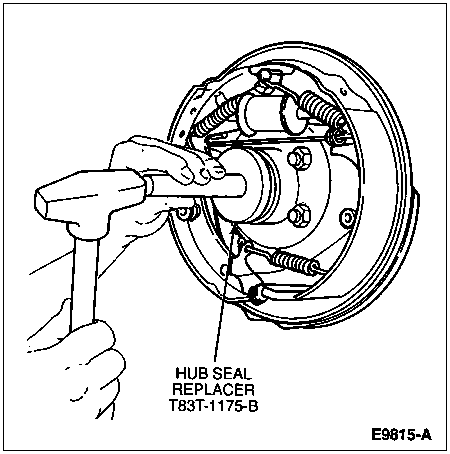
Differential Case Installation
Install differential bearings (4221) on the hubs of the differential case (4204) using Differential Side Bearing Replacer T57L-4221-A2. Press against the bearing cone only.
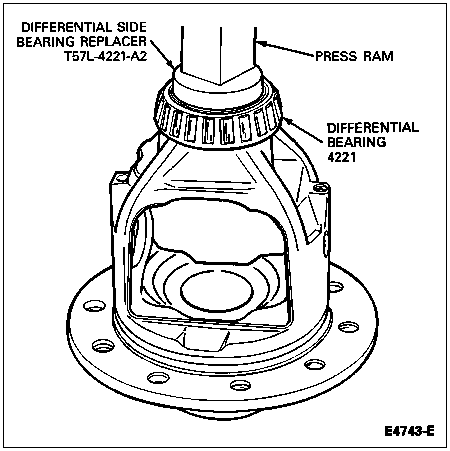
 CAUTION: Extreme care should be taken not to scratch, chip, dent or otherwise cause damage to speed sensor ring or teeth while handling or during assembly.
CAUTION: Extreme care should be taken not to scratch, chip, dent or otherwise cause damage to speed sensor ring or teeth while handling or during assembly.
Align tab on anti-lock speed sensor ring with slot in differential case. Tab on anti-lock speed sensor ring MUST be aligned with slot in differential case. Start two ring gear bolts through the differential case into the ring gear to make sure of case-to-ring gear bolt hole alignment.

| Item | Part Number | Description |
|---|
| 1 | 43114-S100 | Ring Gear Bolts |
| 2 | 4B409 | Anti-Lock Speed Sensor Ring |
| 3 | 4209 | Ring Gear |
| 4 | — | Anti-Lock Speed Sensor Ring Tab (Part of 4B409) |
| 5 | — | Differential Case Slot (Part of 4204) |
Press the NEW anti-lock speed sensor ring and ring gear, if removed, onto the differential case. Apply Threadlock® and Sealer EOAZ-19554-AA or equivalent meeting Ford specification WSK-M2G315-A5 to ring gear bolts and install. Tighten the bolts to 95-115 Nm (70-85 lb-ft).

With pinion depth set and pinion installed, place differential case (with ring gear, anti-lock speed sensor ring, differential pinion thrust washers (4230), differential side gears (4236) and differential bearings) in carrier.

Install a 6.73mm (0.265-inch) shim on left side.

NOTE: Triangles on bearing cups must point outboard.
NOTE: When installing, apply pressure toward left side to make sure the left bearing cup is seated.
Install left bearing cap and tighten bolts finger-tight.

Install progressively larger shims on the right side until the largest shim selected can be assembled with a slight drag feel.

Install right side bearing cap and tighten bolts to 95-115 Nm (70-85 lb-ft).

Rotate assembly to make sure it rotates freely.

Check ring gear and pinion backlash. If backlash is 0.20-0.38mm (0.008-0.015 inch) (0.30-0.38mm [0.012-0.015 inch] preferred) proceed to Step 15. If backlash is zero, go to Step 11. If backlash is not zero, but less than 0.20mm (0.008 inch), or more than 0.38mm (0.015 inch), go to Step 12.
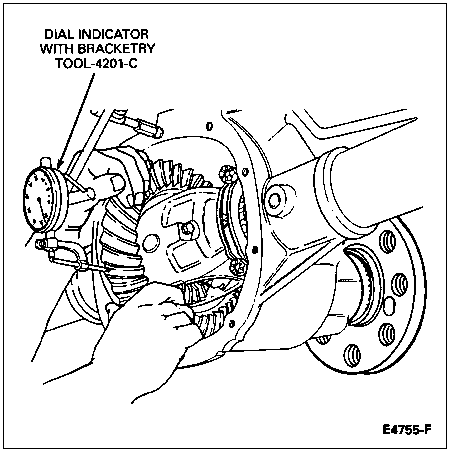
If a zero backlash condition occurs, add 0.5mm (0.020 inch) to the right side and subtract 0.5mm (0.020 inch) from the left side to allow for a backlash reading.
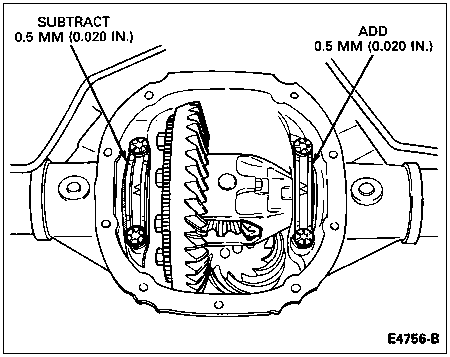
Recheck backlash. See Step 13 if backlash is not within specification. Backlash specification: 0.20-0.38mm (0.008-0.015 inch) (0.30-0.38mm [0.012-0.015 inch] preferred).
If backlash is within specification, go to Step 14.

If backlash is not to specification, correct backlash by increasing thickness of one shim and decreasing thickness of the other by the same amount. Refer to chart for approximate shim change.
SHIM CHANGE CHART
| Backlash Change Required | Thickness Change Required | Backlash Change Required | Thickness Change Required |
|---|
| mm | Inches | mm | Inches | mm | Inches | mm | Inches |
|---|
| 0.025 | 0.001 | 0.050 | 0.002 | 0.228 | 0.009 | 0.304 | 0.012 |
| 0.050 | 0.002 | 0.050 | 0.002 | 0.254 | 0.010 | 0.355 | 0.014 |
| 0.076 | 0.003 | 0.101 | 0.004 | 0.279 | 0.011 | 0.355 | 0.014 |
| 0.101 | 0.004 | 0.152 | 0.006 | 0.304 | 0.012 | 0.406 | 0.016 |
| 0.127 | 0.005 | 0.152 | 0.006 | 0.330 | 0.013 | 0.457 | 0.018 |
| 0.152 | 0.006 | 0.203 | 0.008 | 0.355 | 0.014 | 0.457 | 0.018 |
| 0.178 | 0.007 | 0.254 | 0.010 | 0.381 | 0.015 | 0.508 | 0.020 |
| 0.203 | 0.008 | 0.254 | 0.010 | — | — | — | — |
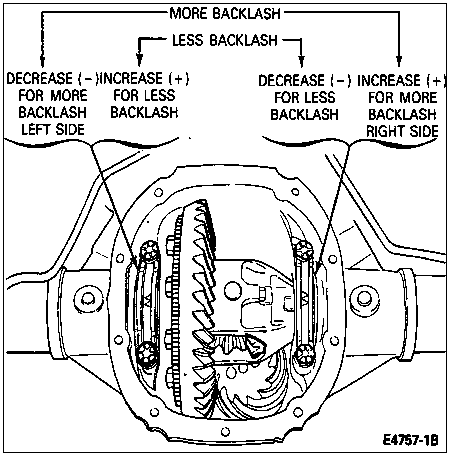
Install shim and bearing cap. Tighten cap bolts to 95-115 Nm (70-85 lb-ft).

Rotate assembly several times to make sure differential bearings seat properly.

Recheck backlash. If backlash is within specification, proceed to Step 17. If backlash is not within specification, repeat Step 13.
Backlash specification: 0.20-0.38mm (0.008-0.015 inch) (0.30-0.38mm [0.012-0.015 inch] preferred).

Remove bearing caps and bolts. To establish differential bearing preload, increase both left and right shim sizes by 0.152mm (0.006 inch) using Shim Driver T85L-4067-AH. Make sure shims are fully seated and assembly turns freely.


Install bearing caps and tighten bolts to 95-115 Nm (70-85 lb-ft). Recheck backlash. If not to specification, repeat Step 12.
Use white marking compound to obtain a tooth mesh contact pattern in your assembly. Pattern legibility can be improved by connecting the driveshaft (4602) and rotating both tires in drive and coast direction.
Reincorporation of pattern inspection is intended to allow technician the ability to detect gross errors in set-up prior to complete reassembly. Pattern contact should be within the primary area of the ring gear tooth surface avoiding any "narrow" or "hard" contact with outer perimeter of tooth (top to root, toe to heel). Pattern inspection should be on the drive (pull) side. Assembly with correct drive pattern will result in satisfactory coast performance. If gross pattern error is detected, with preferred backlash (0.30-0.38mm [0.012-0.015 inch]) recheck pinion shim selection. Refer to Section 05-00 for typical tooth contact patterns.

Axle Shaft Installation
Slide the axle shafts (4234) into place in the rear axle housing. Use care so the splines or any portion of the axle shafts do not damage the inner wheel bearing oil seals. Push the axle shafts inboard enough to allow installation of the u-washers (4N237).
NOTE: A rubber O-ring is used to hold the u-washer in position on the axle shaft. Make sure the O-ring is in the groove at the button end of the axle shaft before installing the u-washer.
Install the u-washers on the button end of the axle shafts and pull the axle shafts outboard so that the shaft lock seats in the counterbore of the differential side gears.
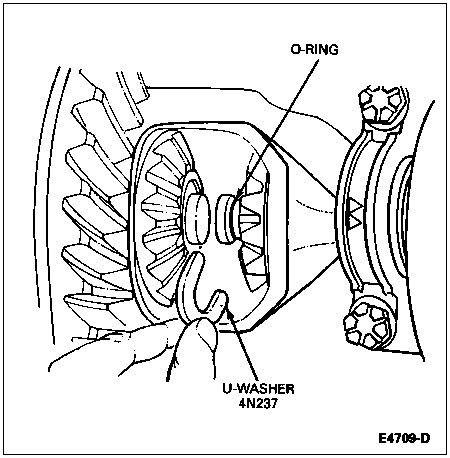
Position the differential pinion shaft (4211) through the differential case and differential pinion gears (4215), aligning the hole in the differential pinion shaft with the bolt hole. Apply Threadlock® and Sealer EOAZ-19554-AA or equivalent meeting Ford specification WSK-M2G315-A5 to the lock pin threads. Install differential pinion shaft lock pin (4241) and tighten to 20-40 Nm (15-30 lb-ft).
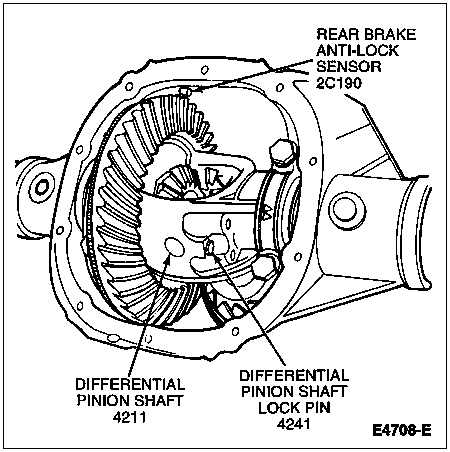
Remove the oil seal replacer from theextension housing (7A039). Install the driveshaft in the extension housing. Align the scribe marks on the rear axle universal joint flange and driveshaft and connect the driveshaft at the rear axle universal joint flange. Tighten attaching bolts and nuts to 83-118 Nm (61-87 lb-ft) for rear axle universal joint flange.

Install the brake drums (1126).
Install the wheels and tires. Tighten the wheel lug nuts (1012) to 100-180 Nm (74-133 lb-ft). Install the wheel covers.
Cover Installation
 CAUTION: Make sure machined surfaces on both axle housing cover (4033) and carrier are clean and free of oil before installing the new silicone sealant. Inside of rear axle must be covered when cleaning the machined surface to prevent contamination.
CAUTION: Make sure machined surfaces on both axle housing cover (4033) and carrier are clean and free of oil before installing the new silicone sealant. Inside of rear axle must be covered when cleaning the machined surface to prevent contamination.
Clean the gasket mating surface of the rear axle carrier casting and axle housing cover.
Apply a new continuous bead of Silicone Rubber D6AZ-19562-AA or -BA or equivalent meeting Ford specification ESB-M4G92-A or ESE-M4G195-A to the new axle housing cover.

NOTE: Axle housing cover must be installed within 15 minutes of application of the silicone or new sealant must be applied. If time permits, allow one hour before filling with lubricant to make sure silicone sealant has properly cured.
Install axle housing cover and tighten bolts to 38-52 Nm (28-38 lb-ft) as shown. Tighten the cover bolts in a cross-wise pattern to prevent axle housing cover from getting cocked.

Add lubricant through the filler hole until the lubricant level is 6.4-14.2mm (1/4 to 9/16 inch) below the bottom of the filler hole with the axle in the running position. Add 5.5 pints of Premium Rear Axle Lubricant XY-80W90-QL or -KL or equivalent meeting Ford specification WSP-M2C197-A, plus four ounces of Ford Friction Modifier F3TZ-19B546-MA or equivalent meeting Ford specification WSP-M2C196-A for complete refill of Traction-Lok® rear axles. Install the filler plug and tighten to 20-40 Nm (15-30 lb-ft).

Sensor, Anti-Lock Brake
Installation
If new rear brake anti-lock sensor (2C190) is to be installed, lightly lubricate O-ring with motor oil.
- Firmly grasp rear brake anti-lock sensor at sides (do not install by applying force on connector) and push into rear axle housing, aligning mounting flange hole with threaded hole in rear axle housing.
- Install hold-down bolt and tighten to 34-40 Nm (25-30 lb-ft).
If old rear brake anti-lock sensor is to be reinstalled, clean and blow off metal particles using compressed air.
- Remove and replace O-ring with a new O-ring.
- Apply a light film of motor oil to new O-ring.
- Firmly grasp rear brake anti-lock sensor at sides (do not install by applying force on connector) and push into rear axle housing, aligning mounting flange hole with threaded hole in rear axle housing.
- Install hold-down bolt and tighten to 34-40 Nm (25-30 lb-ft).

| Item | Part Number | Description |
|---|
| 1 | 390356 | Bolt |
| 2 | 2C190 | Rear Brake Anti-Lock Sensor |
| 3 | — | Connector Seal
(Part of 2C190) |
| 4 | NBR017 | O-Ring |
| A | — | Tighten to 34-40 Nm
(25-30 Lb-Ft) |
Lower vehicle and road test.

































